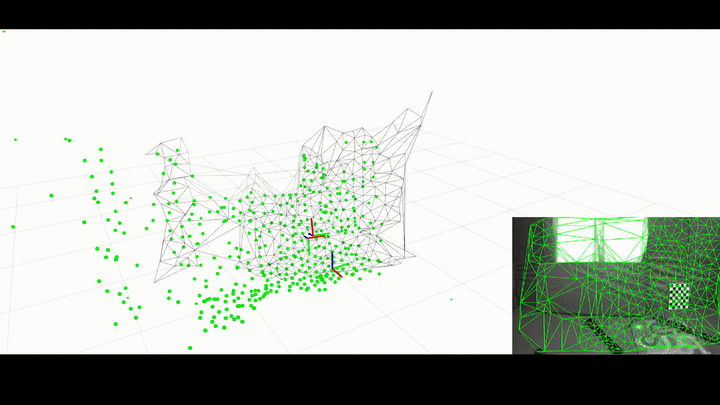MIT-SPARK / Kimera Vio Ros
Projects that are alternatives of or similar to Kimera Vio Ros
Kimera-VIO-ROS
ROS Wrapper for Kimera.
Publications
We kindly ask to cite our paper if you find this library useful:
- A. Rosinol, M. Abate, Y. Chang, L. Carlone, Kimera: an Open-Source Library for Real-Time Metric-Semantic Localization and Mapping. IEEE Intl. Conf. on Robotics and Automation (ICRA), 2020. arXiv:1910.02490.
@InProceedings{Rosinol20icra-Kimera,
title = {Kimera: an Open-Source Library for Real-Time Metric-Semantic Localization and Mapping},
author = {Rosinol, Antoni and Abate, Marcus and Chang, Yun and Carlone, Luca},
year = {2020},
booktitle = {IEEE Intl. Conf. on Robotics and Automation (ICRA)},
url = {https://github.com/MIT-SPARK/Kimera},
pdf = {https://arxiv.org/pdf/1910.02490.pdf}
}
1. Installation
A. Prerequisities
-
Install ROS by following our reference, or the official ROS website.
-
ROS non-default dependencies for mesh_rviz_plugins (change
melodicfor your ROS distribution):
sudo apt-get install ros-melodic-image-geometry ros-melodic-pcl-ros ros-melodic-cv-bridge
- System dependencies:
First, update package list:
sudo apt-get update
sudo apt-get install -y --no-install-recommends apt-utils
sudo apt-get install -y \
cmake build-essential unzip pkg-config autoconf \
libboost-all-dev \
libjpeg-dev libpng-dev libtiff-dev \
# Use libvtk5-dev, libgtk2.0-dev in ubuntu 16.04 \
libvtk6-dev libgtk-3-dev \
libatlas-base-dev gfortran \
libparmetis-dev \
python-wstool python-catkin-tools \
- GTSAM's Optional dependencies (highly recommended for speed)
Install Intel Threaded Building Blocks (TBB):
sudo apt-get install libtbb-dev
B. KimeraVIO ROS wrapper Installation
# Setup catkin workspace
mkdir -p ~/catkin_ws/src
cd ~/catkin_ws/
catkin init
catkin config --cmake-args -DCMAKE_BUILD_TYPE=Release
# On Ubuntu 16.04:
# catkin config --cmake-args -DCMAKE_BUILD_TYPE=Release -DGTSAM_USE_SYSTEM_EIGEN=ON
catkin config --merge-devel
# Add workspace to bashrc for automatic sourcing of workspace.
echo 'source ~/catkin_ws/devel/setup.bash' >> ~/.bashrc
# Clone repo
cd ~/catkin_ws/src
# For ssh:
git clone [email protected]:MIT-SPARK/Kimera-VIO-ROS.git
# For https:
# git clone https://github.com/MIT-SPARK/Kimera-VIO-ROS.git
# Install dependencies from rosinstall file using wstool
wstool init # Use unless wstool is already initialized
# For ssh:
wstool merge Kimera-VIO-ROS/install/kimera_vio_ros_ssh.rosinstall
# For https
# wstool merge Kimera-VIO-ROS/install/kimera_vio_ros_https.rosinstall
# Finally, download and update repos:
wstool update
Finally, compile:
# Compile code
catkin build
# Refresh workspace
source ~/catkin_ws/devel/setup.bash
2. Usage
Download a Euroc rosbag: for example V1_01_easy.
Online
-
As a general good practice, open a new terminal and run:
roscore -
In another terminal, launch KimeraVIO ROS wrapper:
roslaunch kimera_vio_ros kimera_vio_ros_euroc.launch
- In another terminal, launch rviz for visualization:
rviz -d $(rospack find kimera_vio_ros)/rviz/kimera_vio_euroc.rviz
Note: this rviz configuration makes use of a rviz plugin: mesh_rviz_plugins. To visualize the textured 3D mesh, clone this plugin to your catkin workspace and catkin build it (note that this should be done automatically via
wstool).
- Finally, in another terminal, launch the downloaded Euroc rosbag:
rosbag play --clock /PATH/TO/EUROC_ROSBAG
Note that you will need to both source ROS and your
catkin_wsfor each new terminal unless you added the following lines to your~/.bashrcfile:source /opt/ros/melodic/setup.bash # Change `melodic` for your ROS distribution. source ~/catkin_ws/devel/setup.bash # Change `bash` to the shell you use.
Offline
In this mode, the provided rosbag will be first parsed and then sent to the VIO for processing. This is particularly useful when debugging to avoid potential ROS networking issues.
- To run, launch the KimeraVIO ROS wrapper with the
onlineparameter set tofalseand specify the rosbag's path:
roslaunch kimera_vio_ros kimera_vio_ros_euroc.launch online:=false rosbag_path:="PATH/TO/ROSBAG"
Running Unit tests
To run unit tests using catkin for this specific package, call (after building the package and sourcing the workspace):
catkin run_tests --no-deps --this
Other functionalities
Using camera_info topics instead of Yaml parameters
It is sometimes convenient to use the camera_info topics to parse the camera's parameters.
There are currently two ways of using these topics:
- Offline: using the launch file
launch/cam_info_yamlizer.launchwhich will generate yaml files out of the topics. You need to make sure that theframe_ids and the ROS topics are correctly set. Also, mind that the left/right cam frame ids are typically set as static tfs in a rosbag, therefore, first launch the node, and then run the rosbag (in case you see an exception bcs of a missing frame_id). - Online: setting the flag
use_online_cam_params(seelaunch/kimera_vio_ros.launch) to true, and ensuring ROS topics are correctly set.
Restart Kimera-VIO
The typical use case is that you have multiple rosbags and you don't want to be killing Kimera-VIO(-ROS) each time. If this is your case, then we provide a rosservice to restart Kimera-VIO (it will do a hard restart, meaning the whole pipeline and data provider will be destructed and constructed again).
rosservice call /kimera_vio_ros/kimera_vio_ros_node/restart_kimera_vio
Note that Kimera-VIO will complain if timestamps are not strictly increasing. Therefore, one must follow these steps:
- Start Kimera-VIO and rosbag
- Stop rosbag
- Call rosservice to restart VIO
- Start another rosbag
Enable Dense Depth Stereo estimation
This will run OpenCV's StereoBM algorithm, more info can be found here (also checkout this to choose good parameters):
roslaunch kimera_vio_ros kimera_vio_ros_euroc run_stereo_dense:=1
This will publish a /stereo_gray/points2 topic, which you can visualize in Rviz as a 3D pointcloud.
Alternatively, if you want to visualize the depth image, since Rviz does not provide a plugin to
visualize a disparity image, we also run a disparity_image_proc nodelet that will publish the depth image to /stereo_gray/disparity_image_proc/depth/image_raw.
Hardware use
See the documentation on hardware setup for instructions on running KimeraROS on supported hardware platforms, as well as guides on how to develop for other platforms.
BSD License
KimeraVIO ROS wrapper is open source under the BSD license, see the LICENSE.BSD file.

